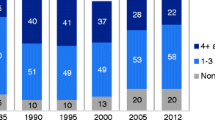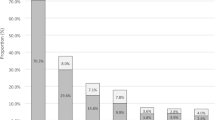Abstract
In this article, findings of a panel study among former EGM gamblers are discussed. The data were collected in two waves during 2007, and 1293 people, 18 years or older, participated. The background for the study was the Norwegian ban on EGMs from 1 July 2007, and the aim was to investigate how this ban affected gambling involvement and problem levels in the sample. The analysis shows that gambling participation, gambling frequencies and gambling problems were reduced after EGMs disappeared from the market. There was no indication of the development of an illegal EGM market, or of substitution of EGMs with other types of gambling. A reduction in other types of gambling is interpreted as an indication of synergetic effects between games. Reduced gambling participation among the most active EGM gamblers, and among risk gamblers, shows that the reductions in gambling availability had an effect even on highly involved gamblers.
Similar content being viewed by others
References
Abbott, M. (2005). Commentaries. Addiction, 100, 1233–1234.
Abbott, M. (2006). Do EGMs and problem gambling go together like a horse and carriage? Gambling Research, 18, 7–38.
Blaszczynski, A. (2005). Commentaries. Addiction, 100, 1230–1231.
Cantinotti, M., & Ladouceur, R. (2008). Harm reduction and electronic gambling machines: Does this pair make a happy couple or is divorce foreseen? Journal of Gambling Studies, 24, 39–54.
Currie, S. R., Hodgins, D. C., Wang, J., el-Guebaly, N., Wynne, H., & Chen, S. (2006). Risk of harm among gamblers in the general population as a function of level of participation in gambling activities. Addiction, 101, 570–580.
Doiron, J. P. (2006). Gambling and problem gambling in Prince Edward Island. Retrieved August 6, 2008, from http://www.gov.pe.ca/photos/original/doh_GambReport.pdf.
Dowling, N., Smith, D., & Thomas, T. (2005). Electronic gaming machines: are they the ‘crack cocaine’ of gambling? Addiction, 100, 33–45.
Götestam, K. G., Johansson, A., Wenzel, H. G., & Simonsen, I.-E. (2004). Validation of the lie/bet screen for pathological gambling on two normal population data sets. Psychological Reports, 95, 1009–1013.
Grun, L., & McKeigue, P. (2000). Prevalence of excessive gambling before and after introduction of a national lottery in the United Kingdom: Another example of the single distribution theory. Addiction, 95, 959–966.
Gyllström, F. (2008, September 3). Pengespill. Utvikling etter reguleringer? (Gambling. Development after regulations?) Paper presented at the seminar “Pengespill og avhengighet – Er de nye automatene snille nok? Vil pengespill på nett overta?” Oslo: arranged by SIRUS.
Johansson, A., & Götestam, K. G. (2003). Gambling and problematic gambling with money among Norwegian youth (12–18 years). Nordic Journal of Psychiatry, 57, 317–321.
Johnson, E. E., Hamer, R. M., & Nora, R. M. (1998). The Lie/Bet questionnaire for screening pathological gamblers: A follow-up study. Psychological Reports, 83, 1219–1224.
Johnson, E. E., Hamer, R., Nora, R. M., Tan, B., Eisenstein, N., & Engelhart, C. (1997). The lie/bet questionnaire for screening pathological gamblers. Psychological Reports, 80, 83–88.
Kavli, H. (2007). Spillevaner og spilleproblemer i den norske befolkningen. (Gambling habits and gambling problems in the Norwegian population.) Report, Oslo Norway: Synovate, MMI.
Lesieur, H. R., & Blume, S. B. (1987). The south oaks gambling screen (SOGS): A new instrument for the identification of pathological gamblers. American Journal of Psychiatry, 144, 1184–1188.
Lund, I. (2006). Gambling and problem gambling in Norway: What part does the gambling machine play? Addiction Research and Theory, 14, 475–491.
Lund, I., & Nordlund, S. (2003). Pengespill og pengespillproblemer i Norge (Gambling and Gambling Problems in Norway) Report no 2, 2003, Oslo, Norway: SIRUS.
Mizerski, D., Jolley, B., & Mizerski, K. (2002). Disputing the “crack cocaine of gambling” label for electronic gaming machines. In A. Blaszczynski (Ed.), Culture and the Gambling Phenomenon. Proceedings of the 11th Conference of the National Association for Gambling Studies, (pp. 276-283). Melbourne: National Association for Gambling Studies.
Norsk, T. (2007). Social report. Retrieved August 6, 2008, from http://www.norsk-tipping.no/page?id=70&tp=lsub.
O’Connor, J., & Dickerson, M. (2003). Definition and measurement of chasing in off-course betting and gaming machine play. Journal of Gambling Studies, 19, 359–386. O’Connor & Dickerson.
Room, R., Turner, N. E., & Ialomiteanu, A. (1999). Community effects of the opening of the Niagara casino. Addiction, 94, 1449–1466.
Shaffer, H. J. (2005). Commentaries. Addiction, 100, 1227–1229.
The Norwegian Gambling Board. (2006). Norske pengespel 2005 (Gaming in Norway 2005). Førde, Norway: Lotteri- og stiftelsestilsynet.
The Norwegian Gambling Board. (2008). Årsmelding 2007 (Yearly report 2007). Førde, Norway: Lotteri- og stiftelsestilsynet.
The Norwegian Gambling Board. (2008b). Hjelpelinjen for Spilleavhengige. Samtalestatistikk. (The helpline for problem gamblers. Calls statistics.). Retrieved August 6, 2008, from http://www.lottstift.no/dav/d3cf09723d.pdf.
Turner, N. E., Ialomiteanu, A., & Room, R. (1999). Chequered expectations: Predictors of approval of opening a casino in the Niagara community. Journal of Gambling Studies, 15, 45–70.
Welte, J. W., Barnes, G. M., Wierczorek, W. F., Tidwell, M.-C. O., & Hoffman, J. H. (2007). Type of gambling and availability as risk factors for problem gambling: A to bit regression analysis by age and gender. International Gambling Studies, 7, 183–198.
Welte, J. W., Barnes, G. M., Wierczorek, W. F., Tidwell, M.-C. O., & Parker, J. C. (2004). Risk factor for pathological gambling. Addictive Behaviors, 29, 323–335.
Welte, J. W., Wierczorek, W. F., Barnes, G. M., & Tidwell, M.-C. O. (2006). Multiple risk factors for frequent and problem gambling: Individual, social and ecological. Journal of Applied Social Psychology, 36, 1548–1568.
Acknowledgement
This study is fully funded by the Norwegian Institute for Alcohol and Drug Research (SIRUS).
Author information
Authors and Affiliations
Corresponding author
Rights and permissions
About this article
Cite this article
Lund, I. Gambling Behaviour and the Prevalence of Gambling Problems in Adult EGM Gamblers when EGMs are Banned. A Natural Experiment. J Gambl Stud 25, 215–225 (2009). https://doi.org/10.1007/s10899-009-9127-y
Received:
Accepted:
Published:
Issue Date:
DOI: https://doi.org/10.1007/s10899-009-9127-y




